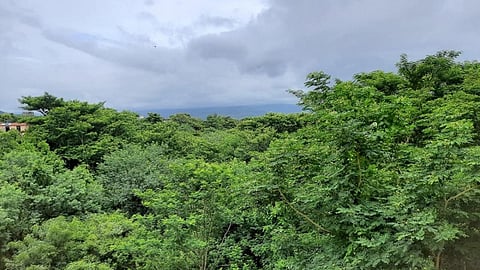
- Topics
- Feature
- Opportunities & Events
- About
- Hindi Portal
- Data
- Topics
- Feature
- Opportunities & Events
- About
- Hindi Portal
- Data

The Western Ghats region of South India is one of the world's most important biodiversity hotspots, and the rainforests of this region are known to harbour 500 types of bird species, 225 reptile species, 219 amphibian species, and 133 mammal species.
This paper 'Low mammalian species richness is associated with Kyasanur Forest disease outbreak risk in deforested landscapes in the Western Ghats, India' published in the journal One Health informs that while only 10 percent of the region's 160,000 km2 area is formally protected, threats to biodiversity in the region are rising. Human induced anthropogenic factors such as deforestation, commercial agricultural exploitation, and urbanisation are taking a toll on the rich biodiversity of the region.
As anthropogenic pressures are increasing, so is the conflict between many of these species, especially mammals and humans for space and resources. This has been increasing the exposure of humans to new types of pathogens, causing a number of new diseases.
For example, a new tick-borne zoonotic viral disease namely
Kyasanur Forest disease virus (KFDV)
,commonly known as monkey fever
has become a critical public health priority in the Western Ghats. Monkeys have been found to be vulnerable to this disease (transmitted primarily by ticks), and spread the infection to humans due to increase in instances of human-animal contact due to destruction of forests. The disease is characterised by high mortality due to neurological and haematological complications among humans.
Kyasanur Forest Disease (KFDV) is known to have its origin in the State of Karnataka where it was first identified after which it spread to the neighbouring states of Tamil Nadu, Maharashtra, Kerala, and Goa.
While the disease virus is transmitted by several tick species, the primary vector is the forest tick, Haemaphysalis spinigera. The forest tick is found in high numbers in the region, has a high viral prevalence, and it feeds on mammalian hosts including humans. Humans are exposed to these ticks in the forest fringes and outbreaks of KFDV are increasing in the five states in the Western Ghats.
While few studies have linked the loss of native forest to the spread of KFDV, some studies indicate that increase in mammalian species and their contact with humans has led to this spread in disease in Karnataka. However, very few studies have looked at the interconnections between KFDV outbreak hotspots, landscape changes and their impact on the ecology and the survival of mammalian species and on communities residing in the region.
The paper presents the findings of a study that aimed at exploring the:
- However,
in areas of increasing forest loss, even if the number of mammalian species was lower, the risk of KFDV increased
. This association was identified at both fine scale and at the level of the taluk.
- KFDV infection circulated among the hosts (monkeys in this case) and spillover to humans was high in human-altered landscapes that had lower biodiversity. This was because these
species adapted to the changes and became highly resilient to destruction of their habitats and biodiversity loss
and thus could spread the disease to humans.
The One Health approach places importance on the role of human mediated ecological changes and biodiversity loss on public health and focuses on the intersection between ecology and landscape changes and epidemiology, animal and public health, health systems, and social sciences to develop a refined understanding of the virus spread and design interventions and surveillance strategies.
It brings together disease managers and policy makers across the public health, animal health, and environmental sectors to design and implement effective disease management strategies.
The paper argues that framing of landscape-based monitoring of wildlife distribution and movement with focus on pathogen surveillance in the context of land use changes can greatly help in shedding light on the spread of the virus from animals to humans. This can help in designing strategies to control and prevent the spread of this rapidly expanding tick-borne viral infection.